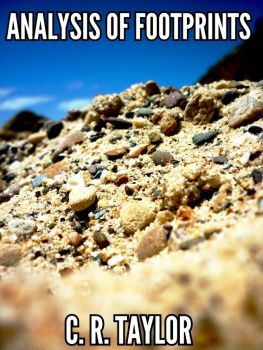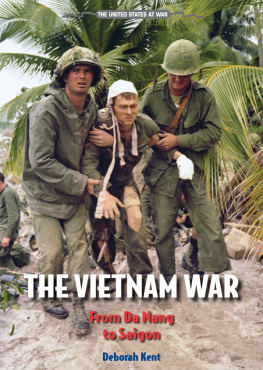
WEYERHAEUSER ENVIRONMENTAL BOOKS
Paul S. Sutter, Editor
WEYERHAEUSER ENVIRONMENTAL BOOKS explore human relationships with natural environments in all their variety and complexity. They seek to cast new light on the ways that natural systems affect human communities, the ways that people affect the environments of which they are a part, and the ways that different cultural conceptions of nature profoundly shape our sense of the world around us. A complete list of the books in the series appears at the end of this book.
FOOTPRINTS OF WAR
Militarized Landscapes in Vietnam
DAVID BIGGS
UNIVERSITY OF WASHINGTON PRESS
Seattle
Footprints of War is published with the assistance of a grant from the Weyerhaeuser Environmental Books Endowment, established by the Weyerhaeuser Company Foundation, members of the Weyerhaeuser family, and Janet and Jack Creighton.
Copyright 2018 by the University of Washington Press
Printed and bound in the United States of America
Composed in Minion Pro, typeface designed by Robert Slimbach
22 21 20 19 185 4 3 2 1
All rights reserved. No part of this publication may be reproduced or transmitted in any form or by any means, electronic or mechanical, including photocopy, recording, or any information storage or retrieval system, without permission in writing from the publisher.
UNIVERSITY OF WASHINGTON PRESS
www.washington.edu/uwpress
COVER PHOTOGRAPH: Firebase Spear, 1971. US National Archives and Records Administration.
LIBRARY OF CONGRESS CATALOGING-IN-PUBLICATION DATA
Names: Biggs, David A., author.
Title: Footprints of war : militarized landscapes in Vietnam / David Biggs.
Description: Seattle : University of Washington Press, [2018] | Series: Weyerhaeuser environmental books | Includes bibliographical references and index. |
Identifiers: LCCN 2018003967 (print) | LCCN 2018004835 (ebook) | ISBN 9780295743875 (ebook) | ISBN 9780295743868 (hardcover ; alk. paper)
Subjects: LCSH: Vietnam, CentralHistory, Military20th century. | Vietnam, CentralEnvironmental conditions. | WarEnvironmental aspectsVietnam, Central. | Indochinese War, 1946-1954Environmental aspectsVietnam, Central. | Vietnam War, 19611975Environmental aspectsVietnam, Central.
Classification: LCC DS559.92.C44 (ebook) | LCC DS559.92.C44 B54 2018 (print) | DDC 304.2/8095974dc23
LC record available at https://lccn.loc.gov/2018003967
The paper used in this publication is acid free and meets the minimum requirements of American National Standard for Information SciencesPermanence of Paper for Printed Library Materials, ANSI Z39.481984.
To my beloved travel companions
Hng Anh, Xun Anh, Kin, and Vinh
CONTENTS
, by Paul S. Sutter
FOREWORD
War Is in the Land
PAUL S. SUTTER
In November of 1986, a happy discovery was made on the northeastern edge of Denver, Colorado: a communal roost of bald eagles. The bald eagle is the national bird of the United States, and today it is thriving. In the 1980s, however, it was an endangered species whose population had been decimated by the spraying of DDT, which biomagnified through the food chain, making eagles eggs brittle and inhibiting their capacity to reproduce. The postwar age of chemical wonders had brought Americas national symbol to the brink of extinction. The US Environmental Protection Agency (EPA) banned DDT for use in the United States in 1972, but bald eagles were still relatively rare in the 1980s. The discovery of these roosts in a stand of mature cottonwood trees was thus an important indicator of slow but steady bald eagle recovery. But there was something unusual, even deeply ironic, about where these eagles had landed. A US Army contractor discovered them within the bounds of the Rocky Mountain Arsenal, long the chief manufacturing facility for chemical weapons and other military chemicals in the United States and, by the 1980s, one of the most desperately polluted places on earth.
The Rocky Mountain Arsenal was a central place in the global history of American military chemicals and their human and environmental impacts. Its existence dates to World War II, when, in the wake of the Pearl Harbor attack, the US Army sought out a site in the inland West to manufacture chemical weapons. In May of 1942, the army selected thirty square miles of land in Adams County, Colorado, just northeast of Denver, removed the farm families who had occupied the site, and rapidly built a facility that produced mustard gas, chlorine agent, lewisite, and napalm. Only the napalm was used during World War II, most notably in the fire-bombing of Japanese cities. At the end of the war, the arsenal was put on standby status, but Cold War realities soon brought it back into service, this time for the production of the powerful nerve agent sarin. During the immediate postwar years, the liquid wastes from chemical manufacturing processes were dumped into unlined holding ponds, where concentrated toxics leached into and spread through the soils and waters of the site. By the late 1950s, signs of contamination were already evident, but chemical production continued. In 1959, after the Soviet Unions successful launch of Sputnik, the US Army added a rocket fuel blending facility, and with the lunar program of the 1960s, chemical rocket propellants became a major production priority. The Shell Chemical Company was also producing pesticides and herbicides on the arsenal grounds from 1952 to 1982. During the 1960s the army shifted to deep-well injection as a purportedly safer method of waste disposal. Then, in 1968, even as napalm and other military chemicals were being used in unprecedented quantities during the Vietnam War, President Lyndon Johnson ordered the destruction of obsolete chemical stockpiles. The Rocky Mountain Arsenal became the place to demilitarize national supplies of mustard gas and sarin, a programnamed, believe it or not, Project Eaglethat would come to define the arsenals 1970s career. By the end of the 1970s, the arsenal had constructed its first groundwater treatment system to contain and mitigate decades of toxic waste dumping. All chemical production and destruction ceased on the site by the early 1980s, and in 1987, a year after that army contractor discovered those roosting bald eagles, the Rocky Mountain Arsenal joined the EPAs list of Superfund sites.
One can learn all about this history of chemical production and contamination by touring the sparkling new visitor center at the Rocky Mountain Arsenal National Wildlife Refuge. Thats right: this place of extraordinary chemical contamination is now a federally protected refuge for wildlife. The 1986 discovery of roosting bald eagles prompted the involvement of the US Fish and Wildlife Service, whose scientists came to recognize that the restricted and contaminated site had allowed wildlife to flourish there. In 1992 President George H. W. Bush signed into law a bill protecting the site as a wildlife refuge, and by 2004, after the EPA certified its cleanup, the army transferred five thousand acres to the Fish and Wildlife Service to formally establish the refuge. In 2010, as a result of continuing cleanup activities, the refuge reached its current size of approximately fifteen thousand acres, complete with a small bison herd, mule deer, burrowing owls, and lots of eagles. The army still owns a core portion of the property to maintain its waste consolidation areas and operate its groundwater treatment facilities, but most of the refuge is now open to hiking and wildlife viewing.
Over the last several decades, as environmental historians have studied the historical impacts of warfare on the natural world, they have noted that many such sites of intense militarization, from US bases that protect large natural landscapes from development to places such as the Korean Demilitarized Zone, have served unintended but important conservation functions. The Rocky Mountain Arsenal National Wildlife Refuge is one of those sites, and it is tempting to render its story as a redemptive one, a tale of a once-toxic place reverting to its original pristine character. The moral of this particular interpretation is that humans and their bellicosity sinned against the land, but wild animals and other natural processes reclaimed the area in a show of natures resilience. Thats a happy story, but its not the whole story, for the legacies of war still haunt this place. Alternatively, we might see the arsenals current status as a wildlife refuge less as a wiping away of the landscapes military legacy than as a reluctant acceptance of its long-term toxicity, for the former Rocky Mountain Arsenal remains too polluted to accommodate human habitation or other intensive forms of human land use. Because of its military past, it will remain a mostly empty space, even as the real estate value of the land around it skyrockets. In that sense, maintaining the site as a wildlife refuge is an inexpensive way of dealing with the ongoing toxic legacies of war. In this reading, the return of wild nature to the site does not erase the footprints of war; it becomes one of them.
Next page










